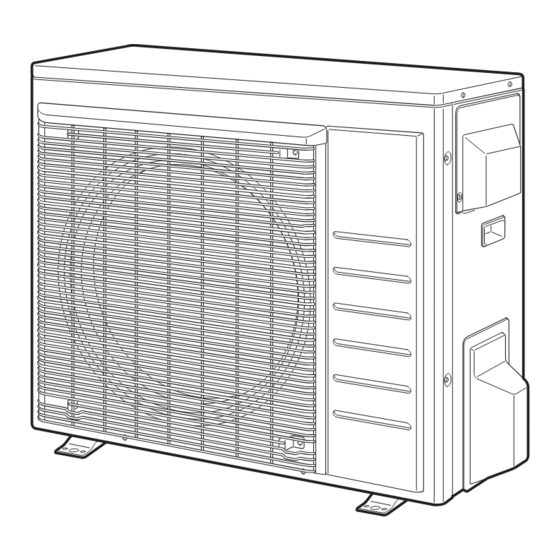
Table of Contents

Summary of Contents for Daikin RX30NMVJU
- Page 1 DAIKIN ROOM AIR CONDITIONER INSTALLATION MANUAL R410A Split Series Installation manual Manuel dinstallation Manuel dinstallation Manual de instalación MODELS RX30NMVJU RX30NMVJUA RX36NMVJU RX36NMVJUA RK30NMVJU RK30NMVJUA RK36NMVJU RK36NMVJUA...
-
Page 2: Table Of Contents
Contents Safety Considerations ........1 4. Refrigerant piping ............6 5. Pressure test and evacuating system ......7 Accessories ............. 3 6. Refilling refrigerant ............8 7. Refrigerant piping work ..........8 Precautions for Selecting a Location ... 3 Wiring ............... 9 Precautions on Installation ...... - Page 3 Corroding copper pipes or soldered parts may result in is shorted and operated forcibly, or parts other than those refrigerant leakage. specified by Daikin are used, fire or explosion may occur. (c) Near machinery emitting electromagnetic waves. Electromagnetic waves may disturb the operation of the control system and cause the unit to malfunction.
-
Page 4: Accessories
Accessories Drain socket* Installation manual This is at the bottom of the packaging. Drain cap (1)* Drain cap (2)* *Only for heat pump models. Warranty Precautions for Selecting a Location 1) Choose a place solid enough to bear the weight and vibration of the unit, where the operating sound will not be amplifi ed. 2) Choose a location where the hot air discharged from the unit or the operating sound will not cause a nuisance to the neighbors of the user. -
Page 5: Precautions On Installation
Precautions on Installation • Check the strength and level of the installation surface so that the unit does not cause any operating vibrations or noise after installation. • Fix the unit in place securely using foundation bolts, as in the figure. (Prepare 4 sets of 5/16 inch (M8) or 3/8 inch (M10) foundation bolts, nuts and washers; all separately available.) • It is best to screw in the foundation bolts until their ends are 3/4 inch (20mm) from the foundation surface. -
Page 6: Installation Space Requirements
Installation Space Requirements • Position the unit on a horizontal surface. Any tilt in the unit (front to back, right to left) should be 3° or less to the horizontal. • Where a wall or other obstacle is in the path of the outdoor unit’s intake or exhaust airflow, follow the installation space requirements below. -
Page 7: Flaring The Pipe End
Flaring the pipe end WARNING • Do not apply mineral oil to the flare. • Prevent mineral oil from getting into the system as this would reduce the service life of the units. • Never use piping which has been used for previous installations. Only use parts which are delivered with this unit. • Never install a dryer to this R410A unit in order to guarantee its service life. -
Page 8: Pressure Test And Evacuating System
Outdoor Unit Installation Pressure test and evacuating system WARNING • Make sure that air or any matter other than refrigerant (R410A) does not get into the refrigeration cycle. • If refrigerant gas leaks should occur, ventilate the room as soon and as much as possible. • R410A, as well as other refrigerants, should always be recovered and never be released directly into the environment. -
Page 9: Refilling Refrigerant
Refilling refrigerant Check the type of refrigerant to be used on the machine nameplate. Precautions when adding R410A Fill from the liquid pipe in liquid form. R410A is a mixed refrigerant, so adding it in gas form may cause the refrigerant composition to change, preventing normal operation. 1) Before filling, check whether the cylinder has a siphon attached or not. (It should have something like “liquid filling siphon attached” displayed on it.) Filling a cylinder with an attached siphon Filling other cylinders Stand the cylinder upright when filling. -
Page 10: Wiring
Wiring WARNING • Do not use tapped wires, extension cords, or starburst connections, as they may cause overheating, electric shock, or fire. • Do not use locally purchased electrical parts inside the product. (Do not branch the power for the drain pump, etc., from the terminal block.) Doing so may cause electric shock or fire. • The circuit must be protected with safety devices in accordance with local and national codes, i.e. a fuse, a circuit breaker, a disconnect or a GFCI. - Page 11 [Method of mounting conduit] 1) Dismount the service lid by removing the 2 screws. 2) Pass wires through the conduit and secure them with a lock nut. 3) After completing the work, reattach the service lid to its original position. Power supply terminal block Service lid Shape wires so that the...
-
Page 12: Facility Setting (Cooling At Low Outdoor Temperature)
Facility Setting (cooling at low outdoor temperature) WARNING Make sure to turn the power OFF before removing the service lid. CAUTION • If the outdoor unit is installed where the heat exchanger of the unit is exposed to direct wind, provide a windbreak wall. • Intermittent noises may be produced by the indoor unit due to the outdoor fan turning on and off when using facility settings. • Do not place humidifiers or other items which might raise the humidity in rooms where facility settings are being used. -
Page 13: Pump Down Operation
Pump Down Operation In order to protect the environment, be sure to pump down when relocating or disposing of the unit. 1) Remove the valve cap from the liquid stop valve and gas stop valve. 2) Carry out forced cooling operation. Hexagonal wrench 3) After 5 to 10 minutes, close the liquid stop valve with a hexagonal wrench. - Page 14 Two-dimensional bar code is a manufacturing code. 3P457793-2A M19B234 (1912) HT...













